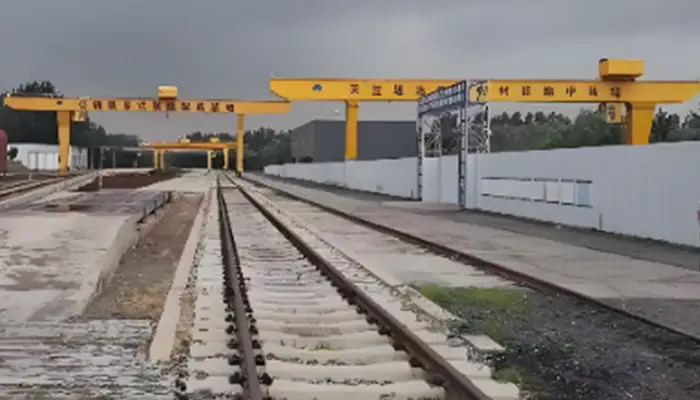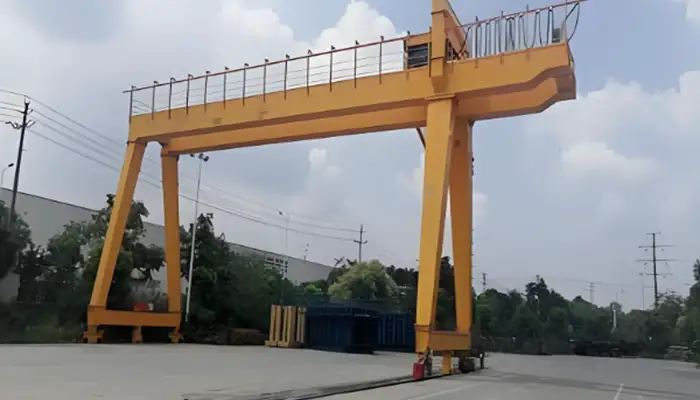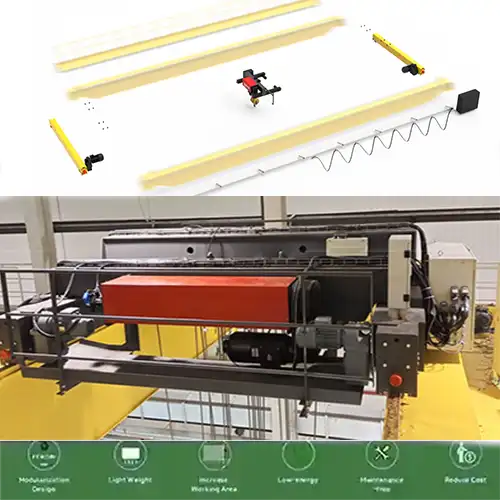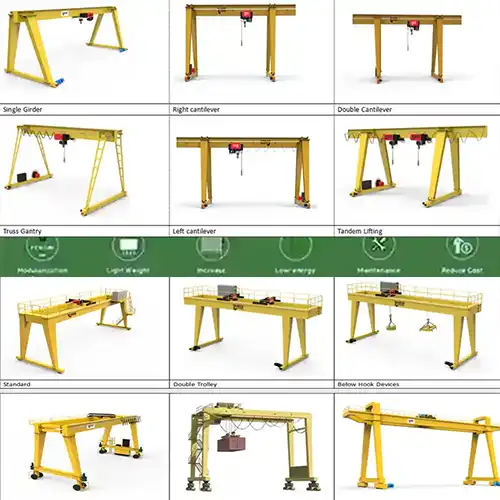10 Ton Gantry Crane for Efficient Railway Cargo – Uzbekistan
Explore how a 10-ton gantry crane improved cargo handling efficiency, safety, and workflow in a Uzbekistan railway yard with customized design and remote control.
Category: 10 Ton Gantry Crane
Your Trusted 10 Ton Gantry Crane Manufacturer & Supplier
10 Ton Gantry Crane for Efficient Cargo Operation in Uzbekistan Railway Yard
Efficient cargo handling is key to keeping a railway yard running smoothly. Even small delays in loading or unloading can affect schedules, slow down operations, and increase labor demands.
Project Goal:
- Implement a 10-ton gantry crane to streamline cargo handling and improve safety.
- Enable the crane to lift heavy cargo, reach inside railcars, and operate efficiently within the yard layout.
Collaboration Approach:
- Crane engineers worked closely with railway yard operators.
- Gained a clear understanding of workflow, cargo types, and daily operational challenges.
- Designed a crane solution tailored to the yard's specific requirements.
The project delivered a reliable, precise, and easy-to-use crane that helps the yard move cargo faster, safer, and more efficiently, meeting the practical needs of day-to-day operations.
Project Overview
The project was carried out at a railway yard in Uzbekistan, focusing on the railway cargo operations sector. The end user, a railway yard operator, needed a solution to handle heavy cargo more efficiently and safely.
To clearly define the project goals, the team outlined the primary objectives for the crane installation.
Project Objectives:
- Improve efficiency: The crane needed to speed up cargo loading and unloading, reducing bottlenecks in daily yard operations.
- Optimize resources: By automating heavy lifting, the yard could reduce manual labor and make better use of existing equipment and personnel.
- Enhance safety: Minimizing manual handling and integrating safety features helped reduce accidents during cargo operations.
Understanding the end user's specific needs was critical to delivering a practical solution.
Key Customer Requirements:
- Maximum lifting capacity: The crane had to handle loads up to 10 tons, matching the typical weight of cargo handled in the yard.
- Cargo access: The design needed to allow the crane to reach inside railcars accurately and safely for efficient loading and unloading.
- Layout compatibility: The crane had to fit within the existing yard layout and workflow patterns, ensuring smooth operation without disrupting other activities.
Customer Requirements Analysis
Before designing the crane solution, the team conducted a detailed assessment of the railway yard. This included examining the yard's infrastructure, types of cargo handled, workflow patterns, and any operational bottlenecks that could affect efficiency or safety.
From this assessment, the team identified specific operational needs for the gantry crane:
- Accurate positioning over railcars: The crane must be able to reach inside railcars precisely for safe and efficient loading and unloading.
- Smooth operation in a high-traffic environment: The crane should operate reliably even with frequent movements and multiple ongoing tasks in the yard.
- Safety and reliability for daily use: The system needs to handle repeated lifting cycles without risk to operators or equipment.
By understanding these requirements, the team was able to design a tailor-made 10-ton gantry crane solution that met the railway yard's practical needs while improving efficiency, safety, and workflow reliability.
Our Solutions
To meet the railway yard's specific needs, we provided a customized 10-ton gantry crane designed for efficient cargo handling. The solution focused on reliability, precision, and practical usability within the high-traffic environment of the yard.
Key Specifications:
- Type: European single girder gantry crane
- Span: 15 meters
- Design: Single cantilever
- Work Duty: A3
- Control Mode: Remote control
Cantilever Feature: The crane includes a cantilever end that extends beyond the main span, allowing it to reach inside railcars directly. This feature ensures accurate hook placement and secure cargo handling, reducing the risk of damage or accidents.
Overall, the design enables efficient loading and unloading, improves safety, and minimizes manual labor, making day-to-day railway operations smoother and more productive.
Benefits for Railway Yard Material Handling Efficiency
The 10-ton gantry crane was successfully installed and put into operation in the Uzbekistan railway yard, immediately impacting daily cargo handling tasks.
Benefits Achieved:
- Faster and more precise loading/unloading: The crane allows accurate placement of hooks and smooth handling of cargo inside railcars.
- Increased productivity and optimized labor usage: Automated lifting reduces the need for manual work and helps staff focus on other critical tasks.
- Enhanced safety: Built-in safety features and precise control minimize the risk of accidents during cargo handling.
Railway yard operators reported significant improvements in workflow efficiency, smoother operations, and easier management of daily cargo handling tasks, demonstrating the crane's practical value in a high-traffic railway environment.
Key Takeaways
This project highlights several practical lessons for implementing gantry cranes in railway yard operations:
- Efficiency and Reliability: Single girder gantry cranes with a cantilever design provide smooth, precise lifting, making them ideal for handling cargo in targeted areas of the yard.
- Tailored Solutions: Taking the time to understand yard-specific workflows, cargo types, and operational patterns ensures the crane meets the practical needs of daily operations.
- Safety and Productivity: Remote control operation combined with accurate hook positioning enhances safety while improving overall productivity, reducing manual labor and operational risks.
- Customizable for International Projects: These cranes can be adapted to other railway yards worldwide, with site-specific design modifications and control options to suit different layouts, cargo types, and power standards.
Overall, the project demonstrates how well-planned, customized gantry crane solutions can improve efficiency, safety, and workflow in railway cargo operations.
Conclusion
This project shows that a 10-ton single girder gantry crane can be effectively customized to meet the specific needs of railway yard operations, improving efficiency, safety, and workflow.
Through careful planning, design adjustments, and close collaboration with the railway yard operators, the crane was integrated smoothly into the existing infrastructure, ensuring reliable and trouble-free operation.
The successful deployment of this crane provides a practical example for other railway yards looking to modernize cargo handling, demonstrating how a tailored gantry crane solution can enhance productivity, reduce labor, and maintain high safety standards in busy rail environments.
Frequently Asked Questions (FAQ) – 10 Ton Gantry Crane for Railway Yards
Q1: How do I know if a 10-ton gantry crane is suitable for my railway yard?
A: It depends on your cargo types, railcar dimensions, and lifting requirements. Buyers often ask whether the crane can reach inside railcars, handle the heaviest loads safely, and operate within a busy yard without disrupting workflow. It's important to review your yard layout and daily handling needs before choosing the crane.
Q2: Can this crane improve efficiency compared to manual handling or older equipment?
A: Absolutely. Many operators want to know how much faster and more precise loading and unloading will be. A single girder crane with a cantilever design allows for accurate hook placement directly over railcars, reducing manual work, minimizing downtime, and increasing productivity.
Q3: How is safety addressed with this type of crane?
A: Safety is a top concern. Operators often ask if the crane has overload protection, emergency stops, and precise control to prevent accidents. With remote control operation and smooth movement, these cranes reduce the risk to personnel and cargo while improving overall handling safety.
Q4: Will this crane fit into an existing railway yard without major modifications?
A: This comes up frequently. Buyers want to ensure the crane can operate within their yard's current layout, runway beams, and traffic patterns. Customization, including span adjustment and cantilever length, ensures the crane integrates seamlessly without the need for extensive structural changes.
Q5: How much maintenance does a 10-ton gantry crane require?
A: Many railway operators ask about ongoing maintenance and operational costs. European-style designs with high-quality components are built for durability, and regular inspections of the hoist, rails, and electrical systems keep the crane running reliably for years with minimal downtime.
Q6: Can this crane solution be adapted for other railway yards or international projects?
A: Yes. Buyers often wonder if the same type of crane can be applied to different yard layouts or international locations. With site-specific design adjustments, electrical configuration compatibility, and control customization, similar cranes can be deployed efficiently in other regions.
Q7: What kind of support is available during installation and commissioning?
A: Railway operators usually ask if technical guidance is provided. A good supplier will offer detailed installation manuals, wiring diagrams, and on-site or remote support for commissioning and training, ensuring smooth adoption and immediate operational efficiency.
Q8: How quickly can the crane be installed and start operating?
A: Time is often a concern for buyers. The installation speed depends on pre-fabrication, yard readiness, and operator training. With proper planning and collaboration between the supplier and yard team, the crane can be operational in a short timeframe while minimizing disruption to cargo operations.
Frequently Asked Questions – Buying a Gantry Crane from China to Uzbekistan
Q1: Is it safe to purchase a gantry crane from a Chinese manufacturer for use in Uzbekistan?
Yes, many buyers successfully import cranes from China. The key is to work with a reputable manufacturer who provides quality certifications, detailed specifications, and clear documentation. It's also important that the crane complies with Uzbekistan's electrical and safety standards.
Q2: How do I ensure the crane meets local standards in Uzbekistan?
Buyers often ask if the crane's electrical system, cable colors, voltage, and frequency are compatible. Suppliers can adjust cable coding, power configuration, and control systems to match Uzbekistan's 380–400V, 50Hz, 3-phase power supply, ensuring safe operation.
Q3: What are the shipping and logistics considerations?
Shipping a gantry crane involves careful planning. Buyers usually ask about packaging, sea freight, customs clearance, and on-site assembly. Properly packed crane sections with clear labels and documentation make handling and installation easier upon arrival.
Q4: How long does it take to receive and install the crane?
Lead times depend on manufacturing, customization, and shipping distance. Many buyers want an estimated timeline from order to on-site commissioning. Working closely with the supplier and providing detailed site information can reduce delays.
Q5: Can the supplier provide technical support remotely or on-site in Uzbekistan?
Yes, technical guidance is crucial. Buyers often ask if the manufacturer provides installation manuals, wiring diagrams, remote setup support, and operator training. Good suppliers offer ongoing assistance to ensure the crane is commissioned safely and efficiently.
Q6: How do I choose the right crane specifications for my railway yard?
Buyers frequently ask how to determine lifting capacity, span, lifting height, duty cycle, and control type. Sharing your yard layout, cargo types, and workflow patterns with the supplier allows them to recommend a crane tailored to your operational needs.
Q7: What about maintenance and spare parts availability?
Many buyers want to know how easy it is to maintain a crane imported from China and where to get replacement parts. Reputable suppliers provide high-quality components, long-lasting hoists, and guidance for preventive maintenance to ensure smooth operation in Uzbekistan.
Q8: Are there risks of delays or hidden costs when buying from China?
Buyers often worry about customs fees, shipping delays, or additional costs. Clear communication with the supplier, confirmed shipping documentation, and understanding import regulations in Uzbekistan help minimize these risks.
Send us an inqury to get tialored 10 ton gantry crane!
Related Products
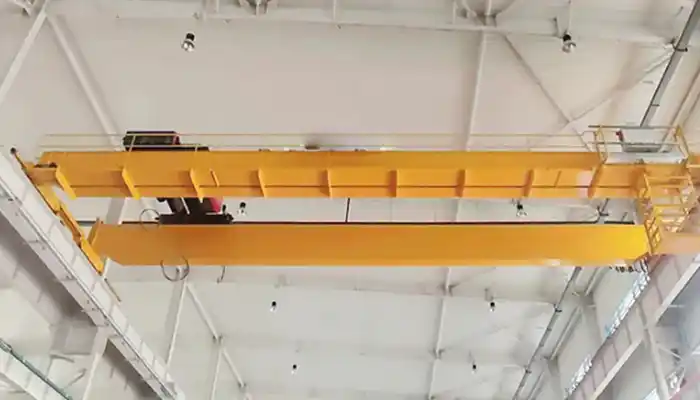
Latest project
Workshop Overhead Crane 5 Ton & 10 Ton Buying Guide
Practical guide for selecting, installing, and maintaining 5 ton to10 ton workshop overhead cranes for safe, efficient, and reliable material handling.
Free consultation to Confirm Parameters & Specifications and Get
Latest Crane Price & Crane Rate.
- Types of overhead cranes : _______?
- Optional: Overhead travelling crane, goliath gantry crane,Slewing jib crane, Single girder or double girder crane,small portable crane or kbk crane, etc.
- Capacity of overhead crane: _______?
- Optional: 0.25ton, 0.5 ton, 1 ton, 2 ton, 3ton, 5 ton, 10 ton,15ton, 20ton, 25 ton, 30ton,35ton, up to 550ton, etc.
- Crane span & lifting height : _______?
- Crane travelling length : _____?
- Control of overhead crane:_______?
- Optional: pendant/ remote/cabin control
- Voltage supply of overhead crane:_____?
- Eg,: 380V50/60HZ,3Phase or others,etc.
- Application/usage of crane:_______?
- Eg,: Steel mill, ,injection mold, cement,stone, concrete,granite, general manufacturing, etc.
Just leave a message via the contact form and our hoist and crane engineer will contact you with in 24working hours.
Get In Touch

